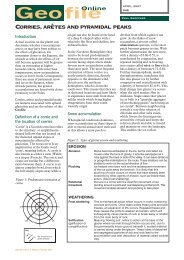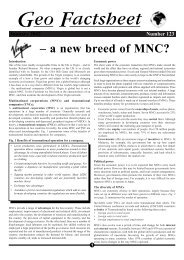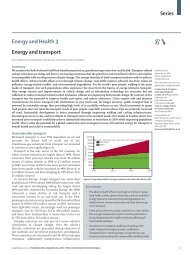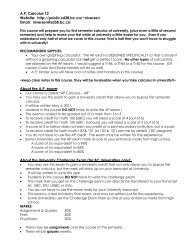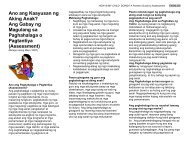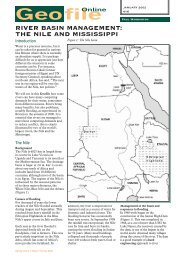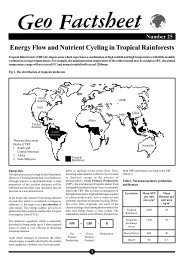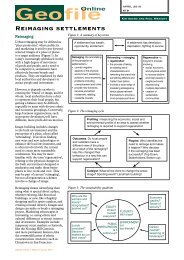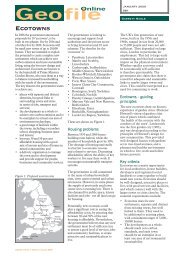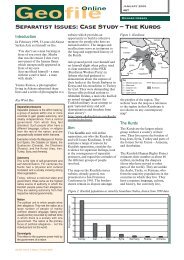80 Antartica.pdf - Richmond School District No. 38
80 Antartica.pdf - Richmond School District No. 38
80 Antartica.pdf - Richmond School District No. 38
You also want an ePaper? Increase the reach of your titles
YUMPU automatically turns print PDFs into web optimized ePapers that Google loves.
12345678901234<br />
12345678901234<br />
12345678901234<br />
12345678901234<br />
12345678901234<br />
12345678901234<br />
12345678901234<br />
12345678901234<br />
Australia<br />
Geo Factsheet<br />
September 1999 Number <strong>80</strong><br />
Antarctica<br />
Antarctica covers 14m km 2 (about 1.5 times the size of the U.S.) and is<br />
composed of 98% ice and 2% rock. The average elevation is between 2000<br />
and 4000 m and mountain ranges extend up to 5000m. It is extremely cold<br />
with temperatures ranging from - 15 0 C to -50 0 C on the plateaus. Antarctica’s<br />
ice holds 2 / 3 of the world’s fresh water, yet most of Antarctica receives less<br />
than 30 mm rain per year which makes it the driest continent. Blizzards are<br />
frequent and cyclonic storms regularly move clockwise along the coast.<br />
Thus, it is a continent of extremes. However, Antarctica also contains<br />
valuable natural resources - iron ore, chromium, copper, gold, nickel,<br />
platinum as well as valuable biotic resources and represents a huge, relatively<br />
undisturbed continental laboratory. As a consequence, many countries<br />
have established research stations on the continent and resource exploitation<br />
is therefore an ongoing threat.<br />
Antarctica is also a major heat sink and nutrient conveyor. The ice<br />
masses that break off Antarctica feed into the cold Antarctic ocean. The<br />
currents in these waters radiate outwards and provide a source of nutrients<br />
for the world's oceans (Fig 1).<br />
Fig 1. Antarctic currents<br />
currents<br />
Antarctica's Conservation value<br />
• Southern Ocean surrounding Antarctica is a very rich ecosystem<br />
• 160m years of the planet's history is preserved in the ice and bedrock<br />
• Continental laboratory<br />
• The world's heat sink, reflecting solar radiation and insulating the<br />
oceans<br />
The sea ice region produces cold and dense Antarctic Bottom Water<br />
which is transported north and this, along with cold surface currents,<br />
serves to cool the oceans it reaches. These waters are replaced by water<br />
flowing south and thus Antarctica serves as a huge heat sink generating<br />
currents which exchange heat and nutrients. The high albedo (reflectivity)<br />
of sea ice also influences temperature and precipitation patterns in the<br />
lower latitudes but the precise mechanisms are poorly understood.<br />
What is certain is that the cold Antarctic water can absorb much more<br />
atmospheric carbon dioxide than warmer water, thus the Antarctic ocean<br />
also acts as a carbon sink. Phytoplankton fix (absorb) this carbon dioxide<br />
and form the basis of complex food webs - this is why Antarctica is highly<br />
biologically productive.<br />
Managing Antarctica<br />
Forty three countries have signed the 1959 Antarctica Treaty which sets<br />
out the legal framework for the management of the continent. Seven<br />
countries - Argentina, Australia, Chile, France, New Zealand, <strong>No</strong>rway and<br />
United Kingdom - have made territorial claims (Fig 2).<br />
Fig 2. International claims in Antarctica<br />
<strong>No</strong>rway<br />
12345678901234<br />
12345678901234<br />
12345678901234<br />
12345678901234<br />
12345678901234<br />
12345678901234<br />
Chile<br />
Britain<br />
Argentina<br />
Weddell<br />
Sea<br />
Indian<br />
Ocean<br />
12345678901234<br />
12345678901234<br />
south pole<br />
Unclaimed<br />
Ross Sea<br />
South Pacific<br />
France<br />
New Zealand<br />
123Bottom water < 0 o C<br />
Britain, Argentina and Chile’s territories overlap. It has been agreed that<br />
whilst the treaty is in force, nothing will be done to enhance or diminish<br />
territorial claims. However, although such territorial claims are not accepted<br />
1
Antarctica<br />
Geo Factsheet<br />
or recognised by countries such as the United States. The 1959 Antarctica<br />
Treaty actually preserved the positions of the seven nations claiming<br />
territory in Antarctica and the nations that do not recognise territory claims.<br />
In practice this means that every decision or agreement which is put forward<br />
is extremely carefully negotiated so that it does not prejudice either group's<br />
legal position.<br />
Antarctica is administered through annual consultative meetings of the<br />
signatories to the Treaty. A range of articles and agreements have been<br />
made (Fig 3).<br />
Fig 3. Major Treaties and Articles<br />
1959 Antarctica Treaty - 12 countries took part in the 1957/58<br />
International Geophysical Year. These are the original 12<br />
signatories.<br />
1972 Convention for the Conservation of Antarctic Seals<br />
19<strong>80</strong> Convention on the Conservation of Antarctic Marine Living<br />
Resources (CCAMLR)<br />
1988 Convention on the Regulation of Antarctic Mining Resource<br />
Activities (CRAMRA)<br />
Major Articles<br />
1. Area to be used for peaceful purposes only, military activity<br />
is prohibited<br />
2. Free development of scientific investigation and co -operation<br />
3. Free exchange of information and personnel between the UN and<br />
other investigative agencies<br />
4. Territory claims will not be established, recognised or disputed<br />
5. Prohibition of nuclear experiments or disposal of radioactive<br />
wastes<br />
6. The treaty includes all land and ice shelves south of 60 0 00'<br />
south<br />
7. Treaty signatories have free access to each other's stations<br />
8. Treaty signatories will discourage actions by any country in<br />
Antarctica that are contrary to the treaty<br />
9. Disputes to be settled peacefully<br />
A number of conventions, acts and protocols also serve to protect various<br />
aspects of the continent’s wildlife.<br />
The Protocol on Environmental Protection to the Antarctic Treaty<br />
came into force in January 1998 and protects the Antarctic environment<br />
against marine pollution and any threats to flora and fauna. It also prohibits<br />
all actions related to mining except scientific research.<br />
Conflicts in Antarctica<br />
Antarctica faces a number of threats (Fig 4).<br />
Fig 4. Conflicts in Antarctica<br />
oil<br />
exploration<br />
mineral<br />
exploration<br />
fishing<br />
research<br />
scientists<br />
tourism<br />
long-range<br />
air pollutants<br />
destruction of stratospheric<br />
ozone allows ultraviolet through<br />
1. Tourism Antarctica receives 12000 visitors annually. Tourism is now<br />
the second largest commercial activity after fishing (Fig 5).<br />
Fig 5. Estimated annual number of tourist visitors to Antarctica<br />
(1956-1996)<br />
Most activity is concentrated in two areas:<br />
1. Antarctica peninsula<br />
2. South Georgia<br />
Access to both areas is largely determined by the pack ice and the major<br />
attractions are the wildlife to be seen.<br />
Impact:<br />
• disturbance to wildlife e.g. through breeding season<br />
• introduction of bird and mammal diseases<br />
• destruction of historical sites<br />
• disposal of waste from cruise ships.<br />
Attempts are being made to try to persuade tourists to visit with tour<br />
operators who are members of The International Association of<br />
Antarctic Tour Operators, one of whose duties is to promote safe and<br />
environmentally responsible travel to the area.<br />
Stratospheric ozone<br />
The stratospheric ozone hole was first discovered in Antarctica. In<br />
1999 the area of thinning of the ozone layer over Antarctica (the<br />
ozone hole) was the largest ever - 29 million km 2 . The extent of the<br />
thinning is largely determined by the concentration of chlorine in the<br />
atmosphere which has been formed from CFCs (Fig 6). Increased<br />
ultraviolet radiation has damaged the DNA of ice fish and phytoplakton<br />
- the latter are the basis of all food chains in the region. The discovery<br />
of Antarctica’s ozone hole led to the Montreal Protocol which has<br />
dramatically decreased CFC production and use.<br />
Fig 6. Stratospheric ozone and chlorine concentration<br />
ozone concentration (dobson units)<br />
number of tourists (thousands)<br />
400<br />
300<br />
200<br />
100<br />
9<br />
8<br />
7<br />
6<br />
5<br />
4<br />
3<br />
2<br />
1<br />
0<br />
1956<br />
ozone<br />
1966<br />
1976<br />
years<br />
1986<br />
chlorine<br />
0<br />
1950 1960 1970 19<strong>80</strong> 1990 2000<br />
year<br />
1996<br />
Atmospheric chlorine (ppbv)<br />
2
Antarctica<br />
Geo Factsheet<br />
Table 1. Known and potential Antarctic resources<br />
Resource<br />
Whales<br />
Krill<br />
Seals<br />
Fish<br />
Oil<br />
Iron<br />
Coal<br />
Other minerals<br />
Potential yield<br />
Potential high, but stocks low and apparently not increasing<br />
110 - 150 million tonnes per annum<br />
Considerable<br />
Substantial, 1997 fin-fish catch 279,000 tonnes<br />
Tens of billions of barrels<br />
Substantial, but low grade<br />
Largest field in the world with approximately 11% of global reserves<br />
<strong>No</strong>t known<br />
When Exploitable<br />
<br />
<strong>No</strong>w<br />
<strong>No</strong>w, but no interest at present<br />
<strong>No</strong>w<br />
<br />
<br />
<br />
<br />
2. Resource management<br />
The potential and known Antarctic resources are summarised in Table 1.<br />
The exploitation of open access marine resources (seals, whales and<br />
finfish) has been unsustainable - following a pattern of discovery,<br />
exploitation, overfishing, collapse. Regulations are now tighter than they<br />
have ever been and sustainable management is a recognised concept.<br />
Seal hunting was the first commercial exploitation of Antarctica’s marine<br />
resources and harvesting quickly reached unsustainable levels. This resulted<br />
in collapse of the industry. The Convention for the Conservation of<br />
Antarctic Seals (1972) has allowed populations to increase and recover.<br />
A similar pattern occurred in the hunting of whale and finfish, both of<br />
which were harvested in huge and unsustainable quantities before they<br />
were regulated.<br />
The 19<strong>80</strong> Convention on the Conservation of Antarctic Marine Living<br />
Resources (CCAMLR) rules that before any conservation measures can<br />
be implemented all 28 signatories must agree to them. The problem is that<br />
it has proved extremely difficult to get such agreement.<br />
One problem has been the lack of scientific data on the size of the resources<br />
e.g. historical fish catches and the distribution and productivity of many<br />
species are still poorly understood. The CCAMLR was unique in that it<br />
set out to protect fisheries at an ecosystem rather than a species level.<br />
CCAMLR stipulates that marine life can only be hunted if ecological<br />
relationships between the species in the area remain unaltered and changes<br />
to the marine ecosystem that are not potentially reversible within 20 -30<br />
years are prohibited. In other words, targeted species can only be hunted if<br />
their predators and prey are not harmed in the process. Such conservation<br />
measures, which take into account ecological interactions, are difficult<br />
to implement and monitor and effectively make the concept of maximum<br />
sustainable yield (MSY) irrelevant.<br />
Protected Areas<br />
The Agreed Measures for the conservation of Antarctic flora and<br />
fauna (1964) protect native mammals and birds. The most important<br />
methods are through the designation of Specially Protected Areas (SPAs),<br />
the protection of seals and the designation of Sites of Special Scientific<br />
Interest (SSSIs).<br />
Problems<br />
1. A disproportionate number of SPAs are terrestrial coastal ecosystems<br />
- thus the designation is spatially biased and unrepresentative.<br />
2. A small percentage area (0.007%) is covered (Table 2)<br />
3. SPAs lack buffer zones<br />
4. SPAs only cover areas of scientific concern and neglect landscape,<br />
scenic and aesthetic sites<br />
5. Scientific Research Stations have been built too close to SPAs<br />
Two new categories of protected area have been suggested:<br />
1. Specially Reserved Areas: designated on the basis of geological,<br />
glaciological, geomorphological, aesthetic, scenic or wilderness qualities.<br />
2. Multiple Use Planning Areas: sites susceptible to cumulative impact.<br />
Table 2. Categories of protected areas with existing site<br />
designations in Antarctica<br />
Category<br />
Specially<br />
Protected Area<br />
(SPA)<br />
Site of Special<br />
Scientific<br />
Interest (SSSI)<br />
Historic Site and<br />
Monument<br />
Seal Reserve<br />
Tomb<br />
CEMP Site<br />
Specially<br />
Reserved Area<br />
(SRA)<br />
Multiple-Use<br />
Planning Area<br />
(MPA)<br />
Area of Special<br />
Tourist Interest<br />
Date<br />
introduced<br />
1966<br />
1972<br />
1972<br />
1972<br />
19<strong>80</strong><br />
1992<br />
1989<br />
1989<br />
1975<br />
Number<br />
and objectives<br />
20<br />
to protect areas of outstanding<br />
scientific interest<br />
35<br />
to prevent interference with<br />
scientific investigations and to<br />
protect sites of exceptional<br />
scientific interest from human<br />
interference<br />
72<br />
to preserve and protect historic<br />
monuments<br />
3<br />
to protect seal breeding areas<br />
1<br />
to ensure that the site of 1979 air<br />
crash on Mount Erebus is left<br />
undisturbed<br />
2<br />
to safeguard sites contributing to<br />
the CCAMLR Ecosystem<br />
Monitoring Programme (CEMP)<br />
1 (4<strong>80</strong> proposed)<br />
to protect areas of outstanding<br />
proposed geological, glaciological,<br />
geomorphological, aesthetic,<br />
scenic or wilderness value<br />
1 (1535 proposed)<br />
to assist in coordinating human<br />
activities<br />
0<br />
areas designated for tourist visits<br />
3
Antarctica<br />
Geo Factsheet<br />
There is an on-going debate about the management of Antarctica. Some believe the Antarctica Treaty is working, others believe Antarctica would<br />
be better protected if it were made a World Park (Table 3).<br />
Table 3. How should Antarctica be managed<br />
Options<br />
Managing Antarctica<br />
Maintaining the treaty<br />
For<br />
The treaty has worked - there has been no attempt<br />
to exploit mineral resources and no military<br />
development has occurred.<br />
CCAMLR provides legal protection for marine<br />
life.<br />
CRAMRA will protect the Antarctic environment<br />
against damaging mineral exploration.<br />
Against<br />
Very difficult to show that ‘scientific research’ is not<br />
exploration for minerals. Although parties are meant<br />
to share information, very little real information<br />
sharing may occur.<br />
Protection depends upon every party agreeing rather<br />
than a majority basis - CCAMLR has not prevented<br />
any exploration of seals, whales and finfish.<br />
Any form of mineral exploration will damage<br />
Antarctica - CRAMRA merely provides a framework<br />
to allow mining rather than prohibit it.<br />
World Park<br />
A WP Treaty would be based upon the<br />
precautionary principle whereby those wishing to<br />
conduct any activity would be required to prove that<br />
there would be no harmful environmental effects.<br />
Mining and exploration would be banned<br />
permanently. The overriding principles would be<br />
peace, co-operation and preservation of wilderness.<br />
Would be very difficult to get agreement between<br />
present signatories. A complete ban leaves no room<br />
for discussion or compromise and would, therefore,<br />
be bound to fail. Without any possibility of future<br />
resource exploration, funding of scientific research<br />
would decline.<br />
3. Minerals<br />
Antarctica has huge potential or speculative resources.<br />
Three main ‘metallogenic’ areas have been identified (Fig 6).<br />
1. East Antarctica<br />
2. Transarctic Mountains<br />
3. Andean Province<br />
Fig 6. Main metallogenic areas of Antarctica<br />
Iron<br />
sub-province<br />
Iron Oxide Vein<br />
sub-province<br />
Copper<br />
sub-province<br />
East Antarctic<br />
Iron Metallogenic<br />
province<br />
Iron-Formation<br />
sub province<br />
Prince<br />
Charles<br />
mountains<br />
South pole<br />
Transantarctic<br />
metallogenic<br />
province<br />
Acknowledgements; This Factsheet was researched and written by Kevin Byrne. Geopress Factsheets may be<br />
copied free of charge by teaching staff or students, provided that their school is a registered subscriber. <strong>No</strong> part<br />
of these Factsheets may be reproduced, stored in a retrieval system, or transmitted, in any other form or by any<br />
other means, without the prior permission of the publisher. ISSN 1351-5136<br />
Most interest has focused on the potential resources of coal, hydrocarbons<br />
and manganese nodules. Coal occurs in Permian and Triassic strata and<br />
the largest quantities occur in the Permian sandstones in the Transantarctic<br />
Mountains. However, at this time the problems of exploiting this resource<br />
seem to prevent economic development.<br />
The most likely sites of hydrocarbons are along the coast of West Antarctica.<br />
The Ross Sea Basin includes three deep troughs filled with sediment and<br />
therefore, probably oil. A major problem in exploiting such resources will<br />
be their depth - the continental shelf has an average cross sectional depth of<br />
500m whilst the average elsewhere in the world is 200m. In addition,<br />
extensive areas of the sea floor are prone to mass movement, gas release<br />
and volcanism - all serious potential hazards.<br />
The 1988 Convention on the Regulation of Antarctic Mineral<br />
Resource Activities (CRAMRA) prohibits mineral exploration unless all<br />
the signatories agree that it could be carried out without environmental<br />
damage. CRAMRA was introduced before there was any clear evidence<br />
that the Antarctic contained valuable minerals. Its supporters say that<br />
such an approach was necessary given the huge potential damage of any<br />
exploration. Its opponents argue that the Convention merely raised<br />
awareness of the potential for exploitation and made it more difficult for<br />
Antarctica to be granted World Park status.<br />
The Madrid Protocol adopted in 1991 prohibits mining but the prohibition<br />
can be lifted if all parties agree. The Protocol also designated Antarctica as<br />
a natural reserve, established environmental principles for the conduct of<br />
all activities and established the need for environmental impact assessment<br />
(EIA) for any actions.<br />
The 1989 sinking of the Bahio Paraiso near Anvers Island and the Exxon<br />
Valdez oil spill in Alaska have increased public concern about possible<br />
harmful effects of minerals activity in Antarctica. However, the ultimate<br />
constraints on resource exploitation in Antarctica are likely to be political<br />
and economic rather than environmental.<br />
4



